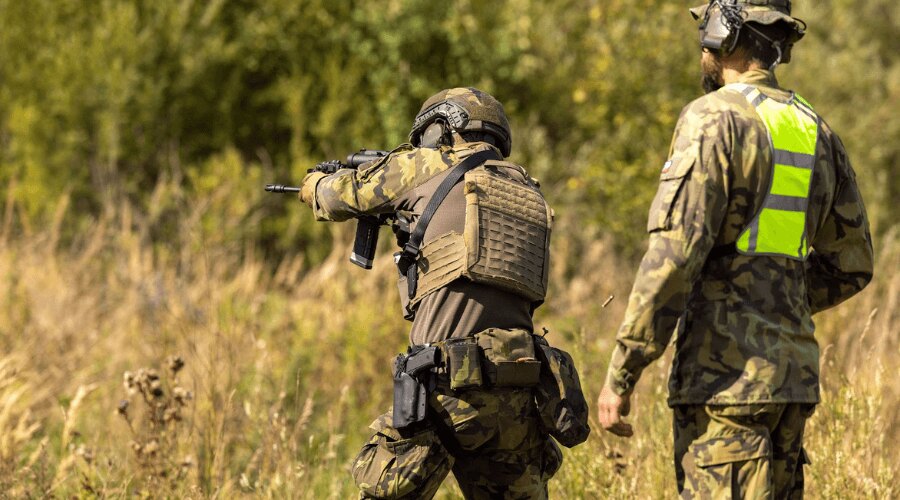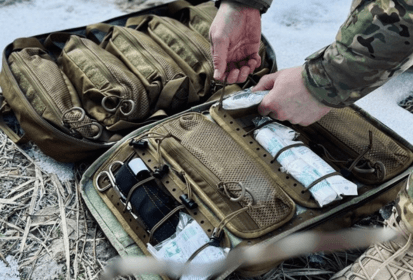Familiarize yourself with combat belts
The combat belt is an element of equipment without which we can no longer imagine a combat uniform nowadays. No matter if we mean military, police or airsoft units. The tactical belt differs from the classic belt, which has the primary task of holding the trousers, in one essential aspect - it is adapted to carry other tactical equipment. But what type will be the most suitable for you and what criteria should you pay attention to in order to perform your tasks with maximum efficiency?
A brief history of combat belts was covered in a recent article. in our magazine. This time we will discuss this important piece of equipment equipment in more detail and look at it from a practical point of view. We will get acquainted with the most common types of combat belts, , their advantages and disadvantages, some practical tweaks and last but not least, we will tell you what to look for when choosing one.

The combat belt is an essential part of the personal equipment of a member of the armed forces. Source: Rigad, SVP 2023.
What is it for?
The combat or service belt is an essential part of the personal equipment of members of the armed forces. But not only that, they can also be used "in civilian life" during everyday wear, outdoor activities, hunting, manual work, etc.
Of course, the belt is primarily used not only to hold your trousers, but mainly to carry important equipment. Its purpose is not only to relieve the shoulders and distribute the weight of the equipment that we would otherwise carry in pouches-holsters">pouches-holsters">pouches on tactical vest and and in our pockets, it should complement the vest in its composition and at the same time be usable on its own in maximum efficiency.
It is therefore advisable to have it assembled and ready for immediate use. The combat belt can be used not only in combat and training actions as a suitable addition to full gear, but also on its own e.g:
- for events that require a quick response and there is no room to put on full gear,
- at the shooting range,
- při pohybu po základně,
- in certain types of reconnaissance missions,
- on guard duty or on patrol,
- as an EDC (Everyday Carry) belt for everyday wear,
- in combination with a suitable holster when carrying a concealed weapon,
- when hunting,
- outdoors or during manual work,
- etc.

Depending on the specific type and equipment, the combat belt platform can also be used "in civilian use", for example as an EDC or work belt. Source: Rigad, SVP 2023.
What are the basic types?
Low profile combat belt
- Single-layer belt (Single Belt, One Piece Belt) has a sophisticated design, MOLLE/PALS system and is often equipped with some type of tactical buckle. Unlike a high profile belt, it is not worn over the top layer of clothing, but is threaded through the loops of your trousers before you can start attaching pouches and other material to it. It is therefore not possible to take it off quickly, put it on quickly or transfer it to other trousers without first having to "stripped it" completely.
- Two-layer belt (Double Belt, Two Piece Belt) or dual belt, is much more practical in this regard. You attach the outer part, which you've already pre-fitted with the appropriate pouches and material, to the inner belt you've already strung up in your trousers using a long velcro panel, and fasten the buckle. This system allows the outer part and all the material to be very quickly and easily put on the belt in your trousers, taken off or moved from one inner belt to another, with all the equipment, which you don't have to take off at all during this procedure. This type of belt is versatile and is suitable as a combat belt as well as a belt for everyday carry or concealed carry of a weapon (also depending on the specific model and its features, of course).
High profile combat belt
The Heavy War Belt (Heavy Duty Belt) falls into this category. It's a sturdy and rigid belt usually with massive padding, which you will appreciate when wearing it for many hours. It is fastened over the top layer of clothing or combat uniform. It is, of course, modular and you can attach all the necessary equipment to it.
Its disadvantage is that it is not firmly fixed to any part of the clothing. When this characteristic is combined with its volume and weight, it often causes it to bounce around and "travel" in various ways, causing discomfort that can drive you crazy over time. The problem is partially alleviated by the carrying strap with which this type of belt is compatible.
For this reason it is not very suitable for high physical activity and dynamic events, but for static activity, long wearing or as a duty belt it is ideal due to its high comfort.

High-profile belts fasten over outerwear and are compatible with the carrying strap. Source: Rigad.
Tactical, combat, service, shooting... so which one?
You may sometimes see a division between tactical and combat belts, but these two terms mean essentially the same thing. Furthermore, it depends on what purpose you will be using your belt for and what material you need for that purpose. This will further determine whether you make it a shooting belt, a duty belt, or perhaps an EDC (Everyday Carry) belt. So tailor it to your needs and try to take full advantage of the features your model has to offer.
According to what should you choose?
Although it may not seem so at first glance, combat belts contain a number of elements that are crucial to their functionality, as well as more or less essential details in which they may differ from each other. We therefore list the most important ones:
- Quality and brand. Don't skimp on the belt. It is a mechanically stressed part of your equipment and usually carries equipment that can save your life. Any imperfection or minor flaw is a weak link that can make the whole system fail at a time when you really don't need it (and you never do). So stick to established brands and avoid cheap substitutes.
- Objective. You choose a different belt as a combat belt when you need to keep your weapon, magazines, IFAK, etc. within reach and your belt needs to be strong, supportive and stable enough. Another will be chosen by a member of the facility security team who attaches a pepper spray pouch, flashlight, or service dog leash to their belt and needs the comfort of being able to run errands for several hours. For hiking or everyday wear, you'll be better off with a lighter, softer belt.
- Vest compatibility. Different models of belts may differ in the type of webbing (single or double row, vertical or horizontal, combination) and the material may be perched at different heights. Make sure that the material on the belt and the bottom edge of the vest do not interfere with each other.
- Trousers compatibility. This refers to low-profile belts that are threaded (in whole or in part) through the belt loops of trousers. The standard width of a belt is 45-50 mm, in addition to which different thicknesses have to be taken into account. The trousers must therefore have a sufficient number of loops of sufficient space.
- The right size. It is important that the belt fits you. Always measure to be sure. If you do not have a size chart, consult the manufacturer for the appropriate size.

Laser cut slits reduce the weight and thickness of the belt.
- Buckle. In combat belts you will encounter different types of buckles including fastex. The most popular types is the Cobra. Another important aspect is the size of the buckle. A large 50mm buckle has a higher load capacity and is easier to handle in gloves. However, if you plan to mostly sit in the belt (e.g. drivers), a large buckle would be uncomfortable and you'd be better off reaching for a smaller one, e.g. 25-35mm. The insides of dual belts are a separate chapter, some fasten with a single buckle, others simply with velcro. It depends on what suits you better.
- Velcro area. With a dual belt it is important that the velcro panel covers as much area as possible and is not "cheated" anywhere. This would be to the detriment of load capacity and stability, the outer part with the material could fall off in an extreme case.
- Accessories and gadgets. There can be a number of functional features, the most popular of which include the D-ring, which can be used for emergency rappelling or for extracting the wounded.
What to do with it?
Hang the material on it
Have you chosen your perfect belt? Well done! Now it's time to attach the material. But even that has a few principles. Probably the most important one is minimuml equipment.
Only the essentials belong on your belt. In other words, the stuff you need to have immediately to hand to save your (or a friend's) life when it comes to breaking bread. It doesn't include any unnecessary items that get in the way and searching for the essentials will rob you of precious seconds. We'll go into more detail on how to effectively fit a combat belt in a future article.
In the case of a combat belt, for example, it is this basic set-up:
- short weapon (on the dominant hand's side),
- tourniquet,
- knife or multitool,
- IFAK (we are still in range of the dominant hand)
- dump pouch,
- magazines for short and long weapon.
Other possibilities of use
Quality combat belt is quite versatile and can be used even in emergency situations, for example:
- to fix the fractured limb,
- as a tow rope,
- to repair a broken backpack,
- to transport the injured,
- as a holder for anything,
- etc.
Readers are further interested











































































































































